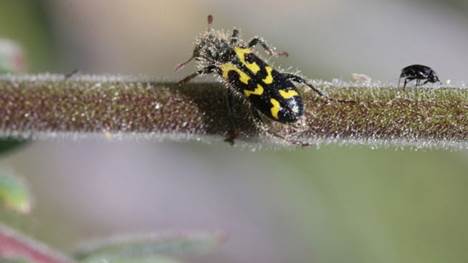

蛇形耧斗菜发现了一个精巧的方法来防御天敌。这种黏乎乎的草是绿棉铃虫(Heliothis phloxiphaga)幼虫最爱的零食,它们咀嚼它的芽、它的花、它的果实。但是,耧斗菜并不试图直接攻击这些令人毛骨悚然的爬虫,相反,它们发出一种化学信号,吸引蜻蜓、甲虫,以及其它昆虫前来。当这些昆虫踏上这种植物,它们就会被耧斗菜黏乎乎、毛绒绒的表面粘住(就像上图的甲虫那样)然后死亡,它们尸体从而将耧斗菜包裹起来。这些死尸反过来又吸引了像蜘蛛这样的肉食动物前来,它们在餐间也会消食这些绿棉铃幼虫。 (蜘蛛经过进化,已经不会被这种植物粘住。)还没有发现有其它植物物种采取这种对天敌的间接防守策略,研究人员在本月的《生态学》杂志上报告说。但文章的作者怀疑,如果再四处搜搜,生物学家也会发现其它采取类似策略的植物。(来源:生物360)
The siren song of a sticky plant: columbines provision mutualist arthropods by attracting and killing passerby insects.
Abstract Many plants provide predatory arthropods with food or shelter. Glandular trichomes entrap insects and may provision predators with insect carrion, though it has not been clear whether this putative benefit functions with natural amounts of carrion, whether plants actively attract insect "tourists", and how common this provisioning system is. We tested the hypothesis that a sticky columbine (Aquilegia eximia: Ranunculaceae) attracts passerby arthropods (a siren song leading them to their demise); that these entrapped arthropods increased predators on the plant; and that these predators reduced damage to the plant. Sticky traps baited with columbine peduncles entrapped more arthropod carrion than unbaited control traps. Predator abundance correlated positively with carrion abundance observationally, and experimental removal of carrion reduced predator numbers. Experimental removal of carrion also increased damage to reproductive structures, likely due to reductions in predator numbers. This indirect defense may be common; we compiled a list of insect-trapping sticky plants which includes over 110 genera in 49 families, suggesting a widespread convergence of this trait, even in non-carnivorous plants. The ubiquity of this trait combined with these experiments suggest that carrion entrapment should be viewed as a common and active process mediated by the plant for indirect defense.
原文链接:http://www.esajournals.org/doi/pdf/10.1890/15-0342.1



